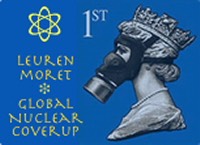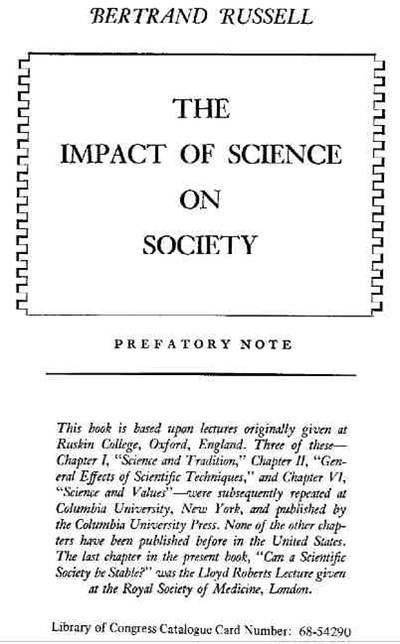💣➷♞💣➷♞💣➷♞💣➷♞💣➷♞💣➷♞💣➷♞💣➷♞💣➷♞💣➷♞💣➷♞💣➷♞💣➷♞💣➷♞
Unless Peace Comes
A Scientific Forecast of New Weapons
July 22, 1968 - Viking Adult - ISBN: 978 067 074 1140 edited by Nigel Calder
With its telling and dispassionate prose and with its life-or-death message, this remarkable and urgently important book should and must chill the hearts and sober the thoughts of anyone who reads it. Nigel Calder is a widely known and respected English science writer and editor. For many years he edited London's New Scientist, which achieved a reputation and influence far beyond its circulation. In this volume he has marshaled the services of sixteen eminent scientists from six countries and asked them from the vantage points of their own disciplines to set down their projections of warfare in the future. No layman who reads this will ever be likely again to characterize the whole scientific community as either oblivious or uncaring. As the French authors of the chapter on chemical warfare put it, "The question may arise: is all science damned? We must either eliminate science or eliminate war. We cannot have both." There is undeniably a chilling fascination in these glimpses into the future— at robot centipede tanks fused with H-bombs; at nerve gases; at refined missiles and submarines; at bacterial weapons; at the fatal fallacies built into atomic deterrence; at the possibilities of tampering with nature itself; at all the political, scientific, and military nightmares which mankind is striving to make real. Yet there is no danger that any reader will for a moment lose sight of the fact that Unless Peace Comes is not an extrapolative catalogue of the gadgetry of warfare but an awesome underlining of the hugest moral imperative in the history of mankind.
Chapter from 'Unless Peace Comes'
HOW TO WRECK THE ENVIRONMENT
by Gordon J. F. MacDonald, U.S.A.
Professor MacDonald is associate director of the Institute of Geophysics and Planetary Physics at the University of California, Los Angeles. His researches have embraced a remarkable diversity of natural phenomena and his professional interests are further extended by his participation in national science policy-making. He is a member of President Johnson’s Science Advisory Committee.
Among future means of obtaining national objectives by force, one possibility hinges on man’s ability to control and manipulate the environment of his planet. When achieved, this power over his environment will provide man with a new force capable of doing great and indiscriminate damage. Our present primitive understanding of deliberate environmental change makes it difficult t o imagine a world in which geophysical warfare is practised. Such a world might be one in which nuclear weapons were effectively banned and the weapons of mass destruction were those of environmental catastrophe.
Alternatively, I can envisage a world of nuclear stability resulting from parity in such weapons, rendered unstable by the development by one nation of an advanced technology capable of modifying the Earth’s environment. Or geophysical weapons may be part of each nation’s armoury. As I will argue, these weapons are peculiarly suited for covert or secret wars.
Science fiction literature contains many suggestions of how wars would progress if man indeed possessed the ability to change weather, climate, or ocean currents. Many of these fictional suggestions, and other more serious discussions, fail to take into account the limitations of nature. Jules Verne gave a detailed discussion of displacing the Earth’s polar caps, thus making the world’s climatic zones more equitable (Les Voyages Extraordinaires; Sans Dessus Dessous, Metzel, 1889). Verne’s proposal was to eliminate the 23º tilt in the Earth’s axis, putting it at right angles to the Sun-Earth plane. However, as Verne correctly pointed out in a subsequent discussion, the Earth’s equatorial bulge stabilizes our planet and even the launching of a 180,000-ton projectile would produce a displacement of only 1/10 micron. Senator Estes Kefauver, Vice-Presidential candidate in the 1956 American election, rediscovered Verne’s original proposal and was seriously concerned with the tipping of the Earth’s axis. He reported that the Earth’s axis could, as the result of an H-bomb explosion, be displaced by 10º. Either Senator Kefauver or his scientific advisers neglected the stabilizing influence of the Earth’s bulge. The maximum displacement that can be expected from the explosion of a 100-megaton H-weapon is less than one micron, as Walter Munk and I pointed out in our book, Rotation of the Earth (Cambridge, 1960).
Substantial progress within the environmental sciences is slowly overcoming the gap between fact and fiction regarding manipulations of the Earth’s physical environment. As these manipulations become possible, history shows that attempts may be made to use them in support of national ambitions. To consider the consequences of environmental modification in struggles among nations, we need to consider the present state of the subject and how postulated developments in the field could lead, ten to fifty years from now, to weapons systems that would use nature in new and perhaps unexpected ways.
The key to geophysical warfare is the identification of the environmental instabilities to which the addition of a small amount of energy would release vastly greater amounts of energy. Environmental instability is a situation in which nature has stored energy in some part of the Earth or its surroundings far in excess of that which is usual. To trigger this instability, the required energy might be introduced violently by explosions or gently by small bits of material able to induce rapid changes by acting as catalysts or nucleating agents. The mechanism for energy storage might be the accumulation of strain over hundreds of millions of years in the solid Earth, or the super-cooling of water vapour in the atmosphere by updraughts taking place over a few tens of minutes. Effects of releasing this energy could be world-wide, as in the case of altering climate, or regional, as in the case of locally excited earthquakes or enhanced precipitation.
WEATHER MODIFICATION
The Earth’s atmosphere is an envelope of air which rotates, for the most part, at the same speed as the underlying continents and oceans. The relative motion between the atmosphere and the Earth arises from sources and sinks of energy which vary in location and strength but which have, as their ultimate source, the Sun’s radiation. The quantities of energy involved in weather systems exceed by a substantial margin the quantity of energy under man’s direct control.
For instance, the typical amount of energy expended in a single tornado funnel is equivalent to about fifty kilotons of explosives; a single thunderstorm tower exchanges about ten times this much energy during its lifetime; an Atlantic hurricane of moderate size may draw from the sea more than 1,000 megatons of energy. These vast quantities of energy make it unlikely that brute-force techniques will lead to sensible weather modification. Results could be achieved, however, by working on the instabilities in the atmosphere.
We are now beginning to understand several kinds of instabilities in the atmosphere. Supercooled water droplets in cold clouds are unstable, but they remain liquid for substantial periods of time unless supplied with nuclei on which they can freeze. Conversion of water droplets to ice through the introduction of artificial nuclei can provide a local source of energy. This released heat can cause rising air currents which in turn lead to further formation of supercooled water. This process may lead to rainfall at the ground greater than that which would have been produced without the artificial nucleation. A second instability may arise, in which water vapour condenses into water, again affecting the distribution of sensible energy. On a larger scale, there is the so-called baroclinic instability of atmospheric waves that girdle the planet. Through the imbalance of heat between equator and pole, energy in this instability is stored, to be released in the creation of large cyclonic storms in the temperate zones. There are other, less well understood instabilities capable of affecting climate; I shall return to them later.
What is the present situation with respect to weather modification and what might be reasonably expected in the future? Experiments over the past eighteen years have demonstrated unequivocally that clouds composed of supercooled water droplets can be transformed into ice-crystal clouds by seeding them with silver iodide, ‘dry ice’ (frozen carbon dioxide) and other suitable chemical agents. This discovery has been applied operationally in the clearance of airports covered by supercooled ground fog. No analogous technique has yet evolved for clearing warm fog, although several promising leads are now being investigated. In the case of warm fog, the atmospheric instability is that water vapour distributed in small drops contains more surface energy than the same water distributed in large drops. The trick for clearance of this warm fog will be to discover some way of getting the small drops to organize themselves into larger ones and then fall to the ground.
There is increasing, though inconclusive, evidence that rainfall from some types of clouds and storm systems in temperate regions can be increased by ten to fifteen per cent by seeding. Somewhat more controversial evidence indicates that precipitation can be increased from tropical cumulus by techniques similar to those employed in temperate regions. Preliminary experiments on hurricanes have the aim of dissipating the clouds surrounding the eye of the storm in order to spread the energy of the hurricane and reduce its force. The results are controversial but indicate that seeding can, in certain circumstances, lead to a marked growth in the seeded cloud. This possibility may have merit in hurricane modification, but experimentation has not yet resulted in a definitive statement.
Regarding the suppression of lightning, there is mixed but largely promising evidence that the frequency of cloud-to-ground strokes can be reduced by the introduction of ‘chaff’, strips of metallic foil of the kind used for creating spurious echoes in enemy radars.
In looking to the future, it is quite clear that substantial advances will be made in all of these areas of weather modification. Today, both military and civilian air transport benefit from progress in the clearance of ground fog. Further progress in the technology of introducing the seeding agent into the fog makes it likely that this type of fog dispersal will become routine. In a sense, fog clearing is the first military application of deliberate manipulation of weather, but it is, of course, very limited.
Large field programmes are being undertaken in the United States to explore further the possibility of enhancing precipitation, particularly in the western and north-eastern states. On the high ground of the western states, snow from winter storms provides much of the country’s moisture. Investigations are under way to see if seeding can lead to an increased snowpack and thus enhance the water resources.
Intense interest in this form of weather modification, coupled with an increased investigation of the physics of clouds, is likely to lead to effective cloud modification within the next five to fifteen years. At present, the effects are measured only statistically and too little has been done in cloud observation before and after seeding in the way of precisely pinpointing which clouds are most likely to be affected.
As far as military applications are concerned, I conjecture that precipitation enhancement would have a limited value in classical tactical situations, and then only in the future when controls are more thoroughly understood. One could, for example, imagine field commanders calling for local enhancement of precipitation to cover or impede various ground operations. An alternative use of cloud seeding might be applied strategically. We are presently uncertain about the effect of seeding on precipitation down wind from the seeded clouds. Preliminary analysis suggests that there is no effect 200-300 miles down wind, but that continued seeding over a long stretch of dry land clearly could remove sufficient moisture to prevent rain 1,000 miles down wind. This extended effect leads to the possibility of covertly removing moisture from the atmosphere so that a nation dependent on water vapour crossing a competitor country could be subjected to years of drought. The operation could be concealed by the statistical irregularity of the atmosphere. A nation possessing superior technology in environmental manipulation could damage an adversary without revealing its intent.
Modification of storms, too, could have major strategic implications. As I have mentioned, preliminary experiments have been carried out on the seeding of hurricanes. The dynamics of hurricanes and the mechanism by which energy is transferred from the ocean into the atmosphere supporting the hurricane are poorly understood. Yet various schemes for both dissipation and steering can be imagined. Although hurricanes originate in tropical regions, they can travel into temperate latitudes, as the residents of New England know only too well. A controlled hurricane could be used as a weapon to terrorize opponents over substantial parts of the populated world.
It is generally supposed that a hurricane draws most of its energy from the sea over which it passes. The necessary process of heat transfer depends on wave action which permits the air to come in contact with a volume of water. This interaction between the air and water also stirs the upper layers of the atmosphere and permits the hurricane to draw on a substantially larger reservoir of heat than just the warm surface water. There may be ways, using monomolecular films of materials like those developed for covering reservoirs to reduce evaporation, for decreasing the local interaction between sea and air and thus preventing the ocean from providing energy to the hurricane in an accelerated fashion. Such a procedure, coupled with selective seeding, might provide hurricane guidance mechanisms. At present we are a long way from having the basic data and understanding necessary to carry out such experiments; nevertheless, the long-term possibility of developing and applying such techniques under the cover of nature’s irregularities presents a disquieting prospect.
CLIMATE MODIFICATION
In considering whether or not climate modification is possible, it is useful to examine climate variations under natural conditions. Firm geological evidence exists of a long sequence of Ice Ages, in the relatively recent past, which shows that the world’s climate has been in a state of slow evolution. There is also good geological, archaeological and historical evidence for a pattern of smaller, more rapid fluctuations superimposed on the slow evolutionary change. For example, in Europe the climate of the early period following the last Ice Age was continental, with hot summers and cold winters. In the sixth millennium B.C., there was a change to a warm humid climate with a mean temperature of 5ºF higher than at present and a heavy rainfall that caused considerable growth of peat. This period, known as a climatic optimum, was accentuated in Scandinavia by a land subsidence which permitted a greater influx of warm Atlantic water into the large Baltic Sea.
The climatic optimum was peculiar. While on the whole there was a very gradual decrease of rainfall, the decrease was interrupted by long droughts during which the surface peat dried. This fluctuation occurred several times, the main dry periods being from 2000 to 1900, 1200 to 1000 and 700 to 500 B.C. The last, a dry heat wave lasting approximately 200 years, was the best developed. The drought, though not sufficiently intense to interrupt the steady development of forests, did cause extensive migrations of peoples from drier to wetter regions.
A change to colder and wetter conditions occurred in Europe about 500 B.C. and was by far the greatest and most abrupt alteration in climate since the end of the last Ice Age. It had a catastrophic effect on the early civilization of Europe: large areas of forest were killed by the rapid growth of peat and the levels of the Alpine lakes rose suddenly, flooding many of the lake settlements. This climatic change did not last long; by the beginning of the Christian era, conditions did not differ greatly from current ones. Since then climatic variations have continued to occur and although none has been as dramatic as that of 500 B.C. a perturbation known as the little ice age of the seventeenth century is a recent noteworthy example. The cause of these historical changes in climate remains shrouded in mystery. The rapid changes of climate in the past suggest to many that there exist instabilities affecting the balance of solar radiation.
Indeed, climate is primarily determined by the balance between the incoming short-wave from the Sun (principally light) and the loss of outgoing long-wave radiation (principally heat).
Three factors dominate the balance: the energy of the Sun, the surface character of terrestrial regions (water, ice, vegetation, desert, etc.), and the transparency of the Earth’s atmosphere to different forms of radiated energy. In the last connection, the effect of clouds in making cool days and relatively warm nights is a matter of familiar experience. But clouds are a manifestation rather than an original determinant of weather and climate; of more fundamental significance is the effect of gases in the atmosphere, which absorb much of the radiation in transit from the Sun to the Earth or from the Earth into space. Intense X-rays and ultra-violet from the Sun, together with high-energy atomic particles, are arrested in the upper atmosphere. Only the narrow band of visible light and some short radio waves traverse the atmosphere without serious interruption.
There has been much controversy in recent years about conjectured overall effects on the world’s climate of emissions of carbon dioxide to the atmosphere from furnaces and engines burning fossil fuels, and some about possible influences of the exhaust from large rockets on the transparency of the upper atmosphere. Carbon dioxide placed in the atmosphere since the start of the industrial revolution has produced an increase in the average temperature of the lower atmosphere of a few tenths of a degree Fahrenheit. The water vapour that may be introduced into the stratosphere by the supersonic transport may also result in a similar temperature rise. In principle it would be feasible to introduce material into the upper atmosphere that would absorb either incoming light (thereby cooling the surface) or outgoing heat (thereby warming the surface). In practice, in the rarefied and windswept upper atmosphere, the material would disperse rather quickly, so that military use of such a technique would probably rely upon global rather than local effects. Moreover, molecular material will tend to decompose, and even elemental materials will eventually be lost by diffusion into space or precipitation to the surface. At intermediate levels, in the stratosphere, materials may tend to accumulate though the mixing time for this part of the atmosphere is certainly less than ten years and may be a few months. If a nation’s meteorologists calculated that a general warming or cooling of the Earth was in their national interest, improving their climate while worsening others, the temptation to release materials from high-altitude rockets might exist. At present we know too little about the paradoxical effects of warming and cooling, however, to tell what the outcome might be.
More sudden, perhaps much briefer but nevertheless disastrous effects, are predictable if chemical or physical means were developed for attacking one of the natural constituents of the atmosphere ozone. A low concentration of ozone (O3, a rare molecular form of oxygen) in a layer between fifteen and fifty kilometres altitude has the utmost significance for life on land. It is responsible for absorbing the greater part of the ultra-violet from the Sun. In mild doses, this radiation causes sunburn; if the full force of it were experienced at the surface, it would be fatal to all life – including farm crops and herds – that could not take shelter. The ozone is replenished daily, but a temporary ‘hole’ in the ozone layer over a target area might be created by physical or chemical action. For example, ultra-violet at 250 millimicrons wavelength decomposes ozone molecules, and ozone reacts readily with a wide range of materials.
At present, we can only tentatively speculate about modifying the short-wave radiation at its source, the Sun. We have discovered major instabilities on the Sun’s surface which might be manipulated many years hence. In a solar flare, for example, 10^10 megatons of energy are stored in distorted magnetic fields. With advanced techniques of launching rockets and setting off large explosions, we may sometime in the future learn to trigger these instabilities. For the near future, however, modification will not be in the short-wave incoming radiation but in the long-wave outgoing radiation.
The usual schemes for modifying climate involve the manipulation of large ice fields. The persistence of these large ice fields is due to the cooling effects of the ice itself, both in reflecting (rather than absorbing) incoming short-wave radiation and in radiating heat at a higher rate than the usual ground cover. A commonly suggested means of climate modification involves thin layers of coloured material spread on an icy surface, thus inhibiting both the reaction and radiation processes, melting the ice, and thereby altering the climate. Such a procedure presents obvious technical and logistic difficulties. For example, if one wished to create a surface coating of as little as one micron thickness to cover a square 1,000 kilometres in size, the total material for this extremely thin coating would weigh a million tons or more, depending upon its density. So the proposals to dust from the air some of the globe’s extended ice sheets, are unrealistic and reflect a brute-force technique, taking no advantage of instabilities within the environment.
While it may be technologically difficult to change an ice cap’s surface character, and thus its thermal properties, it may be possible to move the ice, taking into account the gravitational instability of ice caps. The gravitational potential energy of water as a thick, high ice cap is much greater than it would be at sea level. This fact makes it possible, at least in principle, to devise schemes for bringing about a redistribution in the ice. Indeed, A. T. Wilson has proposed a cyclical theory for the Ice Ages based on this instability.
The main points of Wilson’s theory are as follows:
1. Antarctica is covered by an ice sheet several kilometres thick. Pressure at the bottom of the ice is great enough to keep the ice at or near its melting point; water is an unusual material in that a pressure increase lowers rather than raises its melting point. An increase in thickness of the ice sheet could result in melting at the bottom. The resulting ice-water mixture along the sole of the glacier would permit flow by a process of freezing and melting—a flow process much more effective than ordinary plastic flow.
2. If such an instability occurs, the ice sheet will flow out on to the surrounding sea and a large ice shelf will be formed between Antarctica and the ocean around it. As a consequence, short-wave solar radiation will be reflected and there will be enhanced loss of heat by radiation at the long wavelengths, causing cooling and the inducement of world-wide glaciation.
3. Once the ice shelf is in the ocean, it will begin to melt and eventually will be removed. The ice remaining on land will be much thinner than before. As the reflectivity of the southern hemisphere decreases with the melting of the Antarctic ice cap, the global climate will grow warmer again, corresponding to the start of an interglacial period. The ice cap will slowly form again.
Commenting on Wilson’s theory, J. T. Hollin has noted the possibility of a catastrophic surge or advance of the ice sheet, such as has been recorded from small glaciers on numerous occasions. The largest surge yet reported is probably that of the ice cap in Spitsbergen which advanced up to twenty-one kilometres on a front of thirty kilometres sometime between 1935 and 1938. There are also reports of glacial advances at speeds up to 100 metres per day. Hollin speculates that, once the bottom-melting phase of a gravitationally unstable ice cap is reached, it will move quickly. In addition to trapped geothermal heat melting the ice at the bottom, there are additional contributions from frictional heat generated as the glacier scrapes along the solid ground.
If the speculative theory of Wilson is correct (and there are many attractive features to it) then a mechanism does exist for catastrophically altering the Earth’s climate. The release of thermal energy, perhaps through nuclear explosions along the base of an ice sheet, could initiate outward sliding of the ice sheet which would then be sustained by gravitational energy. One megaton of energy is sufficient to melt about 100 million tons of ice. One hundred megatons of energy would convert 0.1 cm of ice into a thin layer of water covering the entire Antarctic ice cap. Lesser amounts of energy suitably placed could undoubtedly initiate the outward flow of the ice.
What would be the consequences of such an operation? The immediate effect of this vast quantity of ice surging into the water, if velocities of 100 metres per day are appropriate, would be to create massive tsunamis (tidal waves) which would completely wreck coastal regions even in the northern hemisphere. There would then follow marked changes in climate brought about by the suddenly changed reflectivity of the Earth. At a rate of 100 metres per day, the centre of the ice sheet would reach the land’s edge in forty years.
Who would stand to benefit from such application? The logical candidate, would be a landlocked equatorial country. An extended glacial period would ensure near-Arctic conditions over much of the temperate zone, but temperate climate with abundant rainfall would be the rule in the present tropical regions.
FUTURE OF WEATHER AND CLIMATE MODIFICATION
The foregoing perhaps represents a more positive view of weather and climate modification than that held by many Earth scientists. I believe this view is justified as it is based on three scientific and technological advances. First, understanding of basic meteorology has advanced to such an extent that mathematical models of the atmosphere here have been developed incorporating the most important elements. Physical processes in clouds, in turbulent exchanges at the surface, and in transmission of radiation through the atmosphere are no longer as mysterious as they once were. The volumes simulated by the models range from the size of a single cloud to the entire atmosphere; these models are no longer primitive representations.
Secondly, the advent of high-speed computers enables atmospheric models to be studied in greater detail. These computers have a peculiar importance to weather modification, since they will enable scientists to carry out extended experiments to test whether or not various schemes for manipulating the atmosphere are indeed possible and what the outcome should be.
The third advance lending support to expectations for weather and climate modification is the new array of instruments developed to observe and detect changes in the atmosphere. The most dramatic and perhaps the most powerful is the meteorological satellite which provides a platform whence the atmosphere can be observed, not only in geographically inaccessible regions, but also with entirely new physical measurements. For example, meteorological satellites of the future will permit the determination of humidity, temperature and pressure as averaged over substantial volumes of the atmosphere, providing quantities which are needed to develop the mathematical models. Sophisticated surface instrumentation, for observing detailed processes within smaller parts of the atmosphere, provides us with far more powerful tools with which to look at clouds and at the interaction of the atmosphere with its boundaries than those which were available ten or twenty years ago.
EARTHQUAKE MODIFICATION
What causes earthquakes? Over geological time, the irregular distribution of heat-producing radioactive elements in the rock layers gives rise to sub-surface temperature differences between various parts of the Earth. In the continents, granites and similar rocks have concentrated radioactive elements near the surface; no similar concentration has taken place in the sub-oceanic regions, which may as a result be more than 100ºC cooler than the corresponding sub-continental regions. Such variations in temperature along a horizontal line, due to the differences in the vertical distribution of heat-producing elements, give rise to large thermal stresses, causing strain analogous to that which cracks a glass tumbler filled with hot water. The strain tends to be greatest in regions of abrupt temperature change along a horizontal line through the Earth’s crust. The strain may be partially relieved by the slow convective flow of material in the deep Earth which is thought by some geophysicists to push continents about. But the strain can also be relieved by sharp fractures or by movements along previous faults in rocks near the surface. Movement along a fault radiates energy outward, which results in an earthquake. Each year approximately 200 megatons of strain energy is released in this fashion, the largest earthquakes corresponding to energy of the order of 100 megatons. The energy released depends on the volume of material affected. The largest earthquakes take place along faults having a linear dimension of 1,000 kilometres, whereas smaller ones take place along faults of one kilometre or less.
Major earthquakes tend to be located along two main belts. One belt, along which about eighty-five per cent of the total energy is released, passes around the Pacific and affects countries whose coastlines border this ocean, for example Japan and the west coast of North America. The second belt passes through the Mediterranean regions eastwards through Asia and joins the first belt in Indonesia. Along these two belts, large earthquakes occur with varying frequencies. In California, a large earthquake might be expected once every 50 to 100 years, while Chile might expect such a disturbance once every ten to twenty years. Sometimes major earthquakes have occurred in regions ordinarily thought of as being free from risk. For example, the New Madrid earthquake of 1811-12 devastated a large area of central North America but had only slight cultural effects because of the area’s sparse population.
Today, our detailed understanding of the mechanism that causes an earthquake and of how the related instabilities can be triggered is limited. Only within the last few years have serious discussions of earthquake prediction begun, whereas moderately reliable weather forecasts have been available for about the last thirty to fifty years.
Currently, substantial effort is being made, primarily by Japan and the United States, to develop techniques for forecasting earthquakes. These techniques are based to a large extent on the determination of changing strain conditions of materials in the rocks surrounding recognized fault zones. Of possible value is the observation that, before an earthquake, the accumulating strain accelerates.
Control of earthquakes is a prospect even more distant than that of forecasting although two techniques have been suggested through recent experience.
1. In the course of the underground testing of nuclear weapons at the Nevada test site, it was observed that an explosion apparently released local strain in the Earth. The hypothesis is that the swift buildup of strain due to the sudden release of energy in an explosion discharges strain energy over a large volume of material.
2. Another method of releasing strain energy has appeared from pumping of underground water in the vicinity of Denver, Colorado, which has led to a series of small earthquakes. The hypothesis here is that underground water has provided local lubrication permitting adjacent blocks to slip by one another.
The use as a weapon system of the strain energy instability within the solid Earth requires an effective triggering mechanism. A scheme for pumping water seems clumsy and easily detectable. On the other hand, if the strain pattern in the crust can be accurately determined, the phased or timed release of energy from smaller faults, designed to trigger a large fault at some distance, could be contemplated. This timed release could be activated through small explosions and thus it might be possible to use this release of energy stored in small faults at some distance from a major fault to trigger that major fault. For example, the San Andreas fault zone, passing near Los Angeles and San Francisco, is part of the great earthquake belt surrounding the Pacific. Good knowledge of the strain within this belt might permit the setting off of the San Andreas zone by timed explosions in the China Sea and Philippine Sea. In contrast with certain meteorological operations, it would seem rather unlikely that such an attack could be carried out covertly under the guise of natural earthquakes.
MODIFICATION OF OCEANS
We are still in the very early stages of developing the theory and techniques for predicting the state of the oceans. In the past two decades, methods have been devised for the prediction of surface waves and surface wind distribution. A warning system for the tsunamis (tidal waves) produced by earthquakes has also been developed.
Certain currents within the oceans have been identified, but we do not yet know what the variable components are; that is, what the weather within the ocean is. Thus we have not been able to identify any instabilities within the oceanic circulation that might be easily manipulated. As in the case of the solid Earth, we can only speculate tentatively about how oceanic processes might be controlled.
One instability offering potential as a future weapon system is that associated with tsunamis. These frequently originate from the slumping into the deep ocean of loosely consolidated sediments and rocks perched on the continental shelf. Movement of these sediments can trigger the release of vast quantities of gravitational energy, part of which is converted in the motion of the tsunami. For example if, along a 1,000-kilometre edge of a continental shelf, a block 100 metres deep and 10 kilometres wide were dropped a distance of 100 metres, about 100 megatons of energy would be released. This release would be catastrophic to any coastal nation. How could it be achieved? A series of phased explosions, perhaps setting off natural earthquakes, would be a most effective way. I could even speculate on planning a guided tidal wave, where guidance is achieved by correctly shaping the source which releases energy.
BRAIN WAVES ROUND THE WORLD?
At heights of forty to fifty kilometres above the Earth’s surface, substantial numbers of charged particles are found which make this part of the atmosphere, the ionosphere, a good conductor of electricity. The rocks and oceans are also more conducting than the lower atmosphere. Thus, we live in an insulating atmosphere between two spherical conducting shells or, as the radio engineer would put it, in an Earth-ionosphere cavity, or waveguide. Radio waves striking either conducting shell tend to be reflected back into the cavity, and this phenomenon is what makes conventional long-distance radio communication possible. Only recently, however, has there been any interest in natural electrical resonances within the Earth-ionosphere waveguide. Like any such cavity, the Earth-ionosphere waveguide will tend to sustain radio oscillation at certain frequencies in preference to others. These resonant frequencies are primarily determined by the size of the Earth and the speed of light, but the properties of the ionosphere modify them to a certain extent. The lowest resonances begin at about eight cycles per second, far below the frequencies ordinarily used for radio communication. Because of their long wavelength and small field strength, they are difficult to detect. Moreover, they die down quickly, within 1/16 second or so; in engineering terms, the cavity has a short time constant.
The natural resonant oscillations are excited by lightning strokes, cloud-to-ground strokes being a much more efficient source than horizontal cloud-to-cloud discharges. On the average, about 100 lightning strokes occur each second (primarily concentrated in the equatorial regions) so that normally about six lightning flashes are available to introduce energy before a particular oscillation dies down. A typical oscillation’s field strength is of the order of 0.3 millivolts per metre.
The power of the oscillations varies geographically. For example, for a source located on the equator in Brazil the maximum intensity of the oscillation is near the source and at the opposite side of the Earth (around Indonesia). The intensity is lower in intermediate regions and towards the poles.
One can imagine several ways in which to increase the intensity of such electrical oscillations. The number of lightning strokes per second could be enhanced by artificially increasing their original number. Substantial progress has been made in the understanding of the physics of lightning and of how it might be controlled. The natural oscillations are excited by randomly occurring strokes. The excitation of timed strokes would enhance the efficiency with which energy is injected into an oscillation. Furthermore, the time constant of the oscillation would be doubled by a four-fold increase in the electrical conductivity of the ionosphere, so that any scheme for enhancing that conductivity (for example, by injecting readily ionized vapour) lowers the energy losses and lengthens the time constant, which would permit a greater number of phased lightaing strokes before the decay of an oscillation.
The enhanced low-frequency electrical oscillations in the Earth-ionosphere cavity relate to possible weapons systems through a little understood aspect of brain physiology. Electrical activity in the brain is concentrated at certain frequencies, some of it extremely slow, a little around five cycles per second, and very conspicuous activity (the so-called alpha rhythm) around ten cycles per second.
Some experiments have been done in the use of a flickering light to pull the brain’s alpha rhythm into unnatural synchrony with it; the visual stimulation leads to electrical stimulation. There has also been work on direct electrical driving of the brain. In experiments discussed by Norbert Wiener, a sheet of tin is suspended from the ceiling and connected to a generator working at ten cycles per second. With large field strengths of one or two volts per centimetre oscillating at the alpha-rhythm frequency, decidedly unpleasant sensations are noted by human subjects.
The Brain Research Institute of the University of California is investigating the effect of weak oscillating fields on human behaviour. The field strengths in these experiments are of the order of a few hundredths of a volt per centimetre. Subjects show small but measurable degradation in performance when exposed to oscillating fields for periods of up to fifteen minutes.
The field strengths in these experiments are still much stronger, by a factor of about 1,000, than the observed natural oscillations in the Earth-ionosphere cavity. However, as previously noted, the intensity of the natural fluctuations could bc increased substantially and in principle could be maintained for a long time, as tropical thunder storms are always available for manipulation. The proper geographical location of the source of lightning, coupled with accurately-timed, artificially-excited strokes, could lead to a pattern of oscillations that produced relatively high power levels over certain regions of the Earth and substantially lower levels over other regions. In this way, one could develop a system that would seriously impair brain performance in very large populations in selected regions over an extended period.
The scheme I have suggested is admittedly far-fetched, but I have used it to indicate the rather subtle connections between variations in man’s environmental conditions and his behaviour. Perturbation of the environment can produce changes in behaviour patterns. Since our understanding of both behavioural and environmental manipulation is rudimentary, schemes of behavioural alteration on the surface seem unrealistic. No matter how deeply disturbing the thought of using the environment to manipulate behaviour for national advantage is to some, the technology permitting such use will very probably develop within the next few decades.
SECRET WAR AND CHANGING RELATIONSHIPS
Deficiencies both in the basic understanding of the physical processes in the environment and in the technology of environmental change make it highly unlikely that environmental modification will be an attractive weapon system in any direct military confrontation in the near future. Man already possesses highly effective tools for destruction. Eventually, however, means other than open warfare may be used to secure national advantage. As economic competition among many advanced nations heightens, it may be to a country’s advantage to ensure a peaceful natural environment for itself and a disturbed environment for its competitors. Operations producing such conditions might be carried out covertly, since nature’s great irregularity permits storms, floods, droughts, earthquakes and tidal waves to be viewed as unusual but not unexpected. Such a ‘secret war’ need never be declared or even known by the affected populations. It could go on for years with only the security forces involved being aware of it. The years of drought and storm would be attributed to unkindly nature and only after a nation were thoroughly drained would an armed take-over be attempted.
In addition to their covert nature, a feature common to several modification schemes is their ability to affect the Earth as a whole. The environment knows no political boundaries; it is independent of the institutions based on geography and the effects of modification can be projected from any one point to any other on the Earth.
Because environmental modification may be a dominant feature of future world decades, there is concern that this incipient technology is in total conflict with many of the traditional geographical and political units and concepts.
Political, legal, economic and sociological consequences of deliberate environmental modification, even for peaceful purposes, will be of such complexity that perhaps all our present involvements in nuclear affairs will seem simple. Our understanding of basic environmental science and technology is primitive, but still more primitive are our notions of the proper political forms and procedures to deal with the consequences of modification. All experience shows that less significant technological changes than environmental control finally transform political and social relationships. Experience also shows that these transformations are not necessarily predictable, and that guesses we might make now, based on precedent, are likely to be quite wrong. It would seem, however, that these non-scientific, nontechnological problems are of such magnitude that they deserve consideration by serious students throughout the world if society is to live comfortably in a controlled environment.
Author’s note: In the section on weather modification I have drawn heavily on Weather and Climate Modification (National Academy of Sciences, National Research Council, Washington, zg66). A. T. Wilson’s paper on ‘Origin of Ice Ages’ appeared in Nature, vol. aox, pp. z4y-g (xg64), and J. T. Hollin’s comments in vol. ao8, pp. ra-16 (r 965). Release of tectonic strain by underground nuclear explosion was reported by F. Press and C. Archambeau in Journal of Geophysical Research, vol. 67, pp. 337-43 (1962), and man-made earthquakes in Denver by D. Evans in Geotimes, vol. to, pp. rr-rp. I am grateful to J. Homer and W. Ross Adey of the Brain Research Institute of the University of California at Los Angeles, for information on the experimental investigation of the infiuence of magnetic fields on human behaviour.
https://coto2.files.wordpress.com/2013/11/1968-macdonald-how-to-wreck-the-planet.pdf
http://en.wikipedia.org/wiki/Gordon_J._F._MacDonald
💣➷♞💣➷♞💣➷♞💣➷♞💣➷♞💣➷♞💣➷♞💣➷♞💣➷♞💣➷♞💣➷♞💣➷♞💣➷♞💣➷♞
Visitors to LM:GNC
Leuren Moret: Global Nuclear Coverup
- ❁ Currents
- ⚛ Radiation Omnicide 👥
- 🎥 UC, Davis, Katehi, Illuminati ✠
- 🌎✟☦ One World Religion 🎭
- ♞ Atlanticists v. Putin et al ⚪️
- ✈️ 3 NWO False Flags Connected ➷
- 🔪Ukrainian ✠ Wikileaks 👀 Interview 🎥
- 🚫 Out of Eurasia 🚫
- 💀 Jade Helm, International Implications, NWO Rollouts ⏰
- 🌿 Essential Oils, Nutrition, Frequencies & Health 🌺
- 🎯 R.F.D.E. | H.A.A.R.P. | N.L.P. ⚡️
- ⚛ Leuren Moret: Hiroshima, Nagasaki, Fukushima ⚛
- ❦ Moret & Battis: Jade Helm ❦
- 🌎 New World Order America 🇺🇸
- ⨳ Geopolitics Ukraine | E.U. Judo 🌍
- 👥 Template: Jade Helm
- ✠ America’s Domestic Pacification ✠
- ♨️ Chernobyl, Zaporozhye, Blackmail ⚛
- 💉 REBRANDING DISASTER🔪
- 👤 Eurasian Enigma Arises
- 🔴 Donetsk Nuclear Explosion ⚫️
- 🌍 21st Century Silk Road 🌏
- 🌍 Africa ☗
- ♞ Balkans, The Nameless Triangle
- 🌏 China 🌝
- 🌍 Eurasia 🔴
- 💣 Israel: Out of Erupt!
- ✠ Jesuits/Templar’s Origins & Aims
- 👺 SOROS ✠ NWO 📚 Hacked ✍
- ➴ Pyatt’s ✠ SOROS ♞ Breakfast 🍳
- Breedlove, GOOD RIDDANCE
- 🎱 Obama’s $3 Billion Eurocon 💸
- 🌍 A Psychopath’s Psychopath ✠
- 🔫 Global Hit Squad 💣
- 💀 Neo-Capitalist’s Slave Trade 💰
- 🇺🇸 Bio: Undermine Control
- ↷ Fine Evening For A Minuet ↶
- ✠ Slavery, Then & Now
- 💣 JCS Operation Northwoods
- ✠ The Three Secret Meetings
- Korea Yeonhee (연희) Nuclear Kabuki Theatre
- 🌍 Middle East 💣
- 💣 ISIL: Battered, Retreating 💀
- 🔥 Turkish Coup Attempt 💣
- ⚑ Muslim Brotherhood and ISIS ⚫️
- 🔫💰💉Daesh Terrorist Multi-Tool🔪💣💊
- 🚧 US and Turkey, NWO the Kurds 💸
- ✠ Hitler Bragged on Jesuits ✠
- 🍞 Their Daily Bread & Rubble 💣
- 🔪“Erdogan is Strengthening ISIS”💣
- 🇫🇷 Russia Reveals ISIS’ Money 💰💰
- "Raqqa's Rockefellers” ISIS Full Frontal
- ☞ Smashing Turkey’s Game❌
- 🌍 Juncker | E.U. | Direction ⤣
- 🔪 GLADIO Wolf Kills Russian Pilot ✈︎
- ✈︎ Washington’s SU-24 🎯
- 🌐 Turkey, NATO, War Crime? 🔎
- ➷ 449-Down, ISIL to Go 💣
- 🌎 North America 🔥✠
- 🇷🇺 Russia 🇷🇺
- 🇷🇺 PUTIN OVERHAULS KREMLIN 🏰
- ☛ Who Created ISIS ☚
- 🍳 Food Supply Compromised 🎱
- 🌍 Putin re Ceasefire Syria 🌐
- 👤 Cold War Re-Run 👀
- 🌐 Minsk 101 | Theatre of the Absurd 🌍
- 🌐 Geopolitical Original Sin 🌍
- ♘ Russian Troops | Turkish Border ♘
- 📚 Educating Charlie Rose 🔑
- 🌍 Lavrov's Munich Speech
- 🎱 US Embassy Media Fail 🎭
- ✠ ♛🃏 Putin’s Jar Of Spiders
- 🎱 MOSSAD’S ON THE DOORSTEP 💣
- 📄 This Document is Dynamite 📄
- ♔ The Golden Trap
- ❁ Russian Fusion-Fission
- ❁ Putin’s 7-Point Plan
- ❁ Russian Position Speech
- ✈︎ Ukraine, MH-17, Jesuits Flagged! BRICS Undermined?
- ⏰ Ukraine? 🔥 Bail Out! ✈️
- 💦👤 Psychotropic Zombification ☔️
- 💣 Odessa Trade Union Murders 🔥
- 🃏 Nothing Personal, Just Business 💰
- 💉 BioWeapons for Depopulation 💀
- ⚛ Nuclear Coverup Ukraine | Mines of Zholti Vody 💀
- 🔥 Unsustainable Ukraine 👥
- ☗ ASHES TO ASHES 💀
- 🔪Ukrainian Wikileaks 👀
- ☞ Dispatches From the Front 🔫
- 💣 The Ukrainian Failed State 🌍
- 🔑 Our Decisions Define Us🔑
- ✠ Child Abuse 💀
- 💣 Mozgovoi’s Murder 🔪
- 🎱 Yatsenyuk's Russian Threat 🔮
- ||| Prison Ukraine |||
- ✍ CyberBerkut Reports 👥
- ♨️ Crazy Arseniy’s -USED- Ukraine Fire Sale! ♨️
- ✝ AZOV CRUCIFIXION ✝
- 👤 Eyewitness Debaltsevo Cauldron 💀
- ✍ Historic Slaviansk Doctor Interviewed
- 💀 The Tragedy of Uglegorsk
- ♟ Jan. 2015 Minsk Fail 🃏
- ➷ Tochka Found, Debaltsevo Locked
- 🌍 World Facing Second Chernobyl
- ✈︎ MH-17 AND THE Jesuit Minuet
- ✈︎ MH-17, Jesuits Flagged!, Video
- 💀 Death’s Drummers
- 👤 DPR! Novorossiya Calling
- 💀 Ukraine’s Chernobyl Armor
- 🎱 Gas to Ukraine Blocked
- ❁ Global Nuclear Theatre: Donbass
- ✠ GHOSTS of the 51st BRIGADE
- ❁ Novorossiya: Strelkov Briefing
- 👤 Open Letter to President Putin
- ✈︎ MH-17 Dutch Interim Report
- 💣 Surrendering UA Murdered by Punatives
- ♟ Mutiny of the Euro-Integrators ♟
- ➹ View from Ukraine Operating Room
- ❁ Ukraine’s Violent Escalation
- ❁ Ukrainian Soldier’s Cry for Help
- ⧱ Occupied Ukraine ⧱
- ❁ US State's Nuland Directs Ukrainian Coup
- 📯 Ukraine Deputies Knew Before Maidan
- ❁ Health In 2015
- 💉 Vaccines 💀
- 🎥 Geopolitics, Jesuits & History
- 🎥 Rebranded ✠ The Jesuits ✠
- ⚛ Zaporhyze Nuclear Events & Geopolitics
- ❁ Fukushima Polar Vortex Radiation ❁
- 💀 Embrace, Enfold, Extinguish
- ✈︎ Fear of Flying . . . (1of4)
- ❁ Fukushima: Impact of Fallout On Oceans (Pt.1)
- ❁ Fukushima: Impact of Fallout On Oceans (Pt. 2)
- ❁ North America, Middle East and Fukushima
- ❁ DHS/Napolitano Berkeley Template
- ❁ Fukushima Radiation, Ecocide & Tesla Technology
- ✈︎ Flight 370 Downing
- ✈︎ MH370: The Follow-Up
- ❁ Domestic Radiation Issues
- ❁ Fukushima: Hawaii, Pacific Is. - Unsafe
- ⚛ Fukushima Reactors, Breakdown 1-6 ⚛
- 🌏 International Sites Featuring LM:GNC
- ❁ On To Mongolia 🎥
- 🎥 LKM On Fairdinkum Media 🎥
- ❁ Editorial Page
- ❁ Conversations 📬
- ❁ Waves
- ⚛ Radiation Around The Nation 🌎
- ⚛ Your Radiation #73/74, Sep 10 - 24, 2016 🌎
- ⚛ Your Radiation #71/72, Aug 27 - Sep 10, 2016 🌎
- ⚛ Your Radiation #69/70, July 30 - August 13, 2016 🌎
- ⚛ Your Radiation #67/8,--July 16-30, 2016 🌎
- ⚛ Your Radiation #65-6,--July 2-16, 2016 🌎
- ⚛ Your Radiation #64, July 2-9, 2016 🌎
- ⚛ Your Radiation #62-3, June 18 - July 2, 2016 🌎
- ⚛ Your Radiation #61, June 11-18, 2016 🌎
- ⚛ Your Radiation #60, June 4-11, 2016 🌎
- ⚛ Your Radiation #59, May 28 - June 4, 2016 🌎
- ⚛ Your Radiation #58, May 21-28, 2016 🌎
- ⚛ Your Radiation #57, May 14-21, 2016 🌎
- ⚛ Your Radiation #56, May 7-14, 2016 🌎
- ⚛ Your Radiation #55, Apr 30 - May 7, 2016 🌎
- ⚛ Your Radiation #54, Apr 23-30, 2016 🌎
- ⚛ Your Radiation #53, Apr 16-23, 2016 🌎
- ⚛ Your Radiation #52, Apr 9-16, 2016 🌎
- ⚛ Your Radiation #51, Apr 2-9, 2016 🌎
- ⚛ Your Radiation #47-50, Mar 5 - Apr 2, 2016 🌎
- ⚛ Your Radiation #46, Feb 27-Mar 5, 2016 🌎
- ⚛ Your Radiation #45, Feb 20-27, 2016 🌎
- ⚛ Your Radiation #44, Feb 13-20, 2016 🌎
- ⚛ Your Radiation #43, Feb 6-13, 2016 🌎
- ⚛ Your Radiation #42, Jan 30 - Feb 6, 2016 🌎
- ⚛ Your Radiation #41, Jan 23-30, 2016 🌎
- ⚛ Your Radiation #40, Jan 16-23, 2016 🌎
- ⚛ Your Radiation #39, Jan 9-16, 2016 🌎
- ⚛ Your Radiation #38, Jan 2-9, 2016 🌎
- ⚛ Your Radiation #37, Dec 26 - Jan 2, 2015|16 🌎
- ⚛ Your Radiation #36, Dec 19-26, 2015 🌎
- ⚛ Your Radiation #35, Dec 12-19, 2015 🌎
- ⚛ Your Radiation #34, Dec 5-12, 2015 🌎
- ⚛ Your Radiation #33, Nov 28 - Dec 5, 2015 🌎
- ⚛ Your Radiation #32, Nov 21-28, 2015 🌎
- ⚛ Your Radiation #31, Nov 14-21, 2015 🌎
- ⚛ Your Radiation #30, Nov 7-14, 2015 🌎
- ⚛ Your Radiation #29, Oct 31 - Nov 7, 2015 🌎
- ⚛ Your Radiation #28, Oct 24-31, 2015 🌎
- ⚛ Your Radiation #27, Oct 17-24, 2015 🌎
- ⚛ Your Radiation #26, Oct 10-17, 2015 🌎
- ⚛ Your Radiation #25, Oct 3-10, 2015 🌎
- ⚛ Your Radiation #24, Sep 26 - Oct 2, 2015 🌎
- ⚛ Your Radiation #23, Sep 19-26, 2015 🌎
- ⚛ Your Radiation #22, Sep 12-19, 2015 🌎
- ⚛ Your Radiation #21, Sep 5-12, 2015 🌎
- ⚛ Your Radiation #20, Aug 29 -Sep 5, 2015 🌎
- ⚛ Your Radiation #19, Aug 22-29, 2015 🌎
- ⚛ Your Radiation #18, Aug 15-22, 2015 🌎
- ⚛ Your Radiation #17, Aug 8-15, 2015 🌎
- ⚛ Your Radiation, August 1-8, 2015 🌎
- ⚛ Your Radiation, July 24-31, 2015 🌎
- ⚛ Your Radiation, June 26 - July 24, 2015 🌎
- ⚛ Your Radiation, June 19-26, 2015 🌎
- ⚛ Your Radiation, June 12-19, 2015 🌏
- ⚛ Your Radiation, June 5-12, 2015 🌎
- ⚛ Your Radiation, May 29 - June 5, 2015 🌎
- ⚛ Your Radiation, May 22-29, 2015 🌎
- ⚛ Your Radiation, May 15-22, 2015 🌎
- ⚛ Your Radiation, May 8-15, 2015 🌎
- ⚛ Your Radiation, May 2-8, 2015 🌎
- ⚛ Your Radiation, April 24 - May 1, 2015 🌎
- ⚛ Your Radiation, April 17-24, 2015 🌎
- ⚛ Your Radiation, April 9-16, 2015 🌎
- 🔥 Fire at Oak Ridge 💥
- 💥 NANOWEAPONRY 💥
- 🐄 Radioactive Cattle Teeth, Fukushima 🏭
- 📰 WikiLeaks 🔎 NSA and More 🔦
- ✨Nano ‘Hall of Mirrors’⚡️
- ⚛ 💀 ⚛ into the Hudson River 🌎
- 🚿 Flint, Metropolitan Eugenics 💀
- 🌍 Existential Threat? ☛NATO☚
- 💉 Gates, Poroshenko; Conspiracy, Government 🎯
- 💉 Gates-Poroshenko ZPG Ukraine 💀
- 💀 Paris Massacre Perpetrators 👤
- 🔪 Delgado, Mind Control ♟
- 🌎 MOST NUKED NATION ON EARTH 🌎
- 🎯 Radio Frequency Directed Energy 🎯
- ⚛ Please, Don’t Pick the Mutants 🌻
- ⨳👤⨳ Space-Based Weapons Ban
- √ Saudi OP Strategy Success
- ♨️ Gallery ♨️ Chernobyl Fire ♨️ 2015 ♨️
- 🌍 Monsanto Backdoors E.U.
- 🎉 Crimea’s 1st Anniversary Album 🎉
- 🌏 21st Century Eschalon
- 📰 International Headline Watch 🌏
- ✄ Prouty Place ✑ CUT THE BULL ✂︎
- 🌏 How To Wreck The Environment
- 🇯🇵 Plutonium Isotopes Off Japan
- 🌍 Depopulation Agenda: Europe 👤
- 🔪💉Cease Covert Depopulation Letter🔪💉
- ❁ Dutch Apologize for MH-17 Lies
- ❁ Pacific Dead from Fukushima
- ❁ Strange Fish Story
- ❁ Blood Composition of Monkeys Altered Near Fukushima
- ❁ Secret Army Bases
- ⚛ Fukushima Plutonium Effect ⚛
- ➷ RAND Demographic Military Power ➷
- ⚛ Depleted Uranium | DNA Damage ⚛
- ❁ Hidden Genocide: by Dr. Ernest Sternglass
- ❁ Space Preservation Act of 2001
- ❁ 1972 Rothschild Ball
- ❁ Unsafe Radwaste Disposal
- ♆ Fallout and Reproduction of Ocean Fish Populations
- ⚛ Radiation Around The Nation 🌎
- ❁ Lifestyle
- ❁ Archive
- ⚛ 61 Years of Omnicide ⚛
- 📻 Nanoparticle Toxicity with Leuren Moret ❦
- ❁ New Bombs and War Crimes in Fallujah
- ❁ Global Climate Change . . .
- ⚛ International Radiation Distribution ⚛
- 💀 Depleted Uranium’n’DNA 😱
- ❁ UC Regents Lose Nuke Pgm
- ❁ DU-Trojan Horse
- ❁ LM:GNC (Pt1)
- ❁ LM:GNC (Pt2)
- ❁ World Uranium Weapons Conference 2003
- ⚛ Radionuclide ReMobilization Abatement
- ❁ "America First" Transcription
- ❁ "Whale Archive" Transcription
- ⚛ ⚛ ⚛ Location, Leuren Moret: Global Nuclear Coverup ⚛ ⚛ ⚛
- ❁ Glossary
- ❁ Contact
# # #








![20120724 - 7-24-2012 The More We Learn - quote from David Rockfeller -_thumb[2]](../_Media/20120724---7-24-2012-the_med_hr.jpeg)




